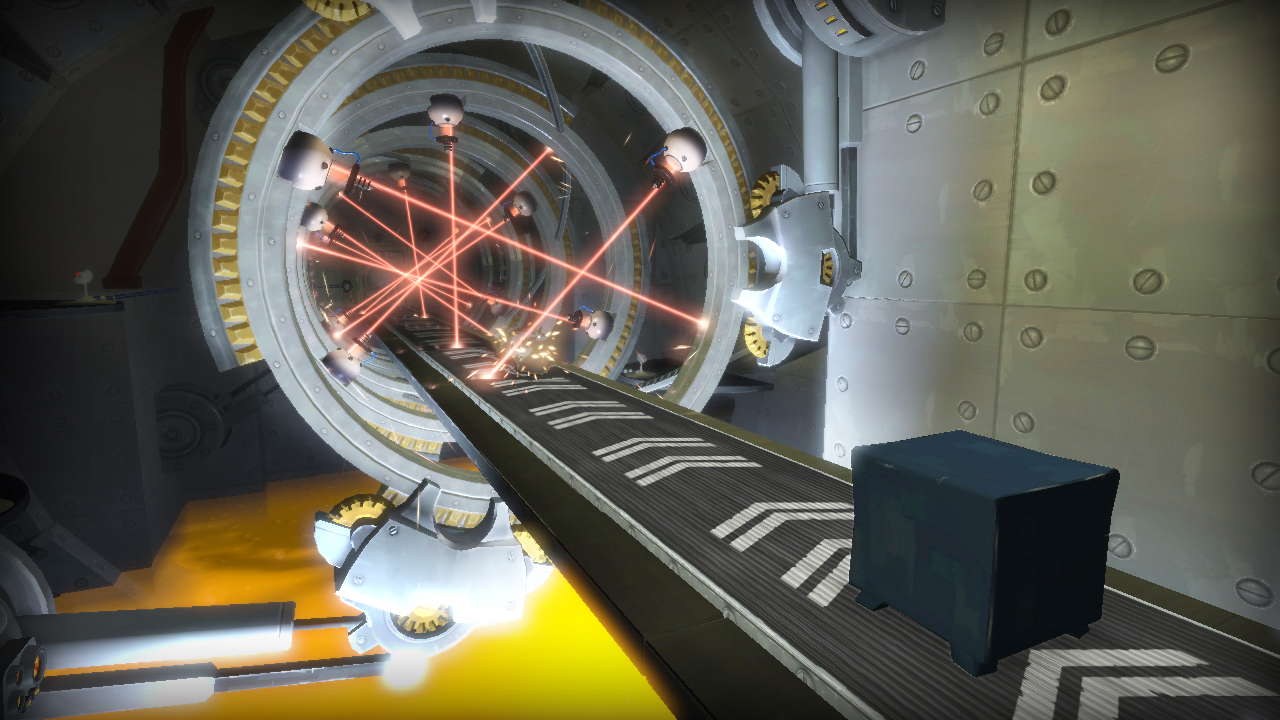
Portal is one of my favorite games of all time. I love it so much that I even learned to play “Still Alive” on the ukulele. Knowing that Kim Swift, the Portal designer who went on to join Airtight Games, led Quantum Conundrum’s development only added to my intense anticipation for this title.
Journalists have quoted Swift saying that she wants to create games that are accessible to a wider market with enough challenge to satisfy more experienced players. Quantum Conundrum is a fantastic attempt at doing just that even if it doesn’t quite hit all the bullet points that such a widely appealing yet core-gamer-pleasing experience would need to have. It isn’t perfection, but it’s a brilliant try all the same.
Players will take on the role of a young child, aged somewhere between 10 and 12, who visits his wacky mad-scientist uncle’s house every year. This time, the boy arrives to find his relative missing and only able to communicate by voice. Professor Fitz Qwadrangle is the uncle’s name, and science-juice-fueled dimensional trickery is his game. With the aid of a dimension switching glove and several “batteries,” the player must move through each environment to ultimately restore power to three generators throughout the seemingly endless corridors and rooms of Qwadrangle Mansion.
WHAT YOU’LL LIKE
Dimensional shifting is a delight
The central gameplay mechanic here is that of changing the environment’s basic physical laws along fairly straightforward lines to access areas and avoid obstacles along the way.
In the fluffy dimension, all objects weigh far less than they otherwise would. Players can pick up and fling safes and couches with ease. The heavy dimension is the polar opposite: Objects have incredible weight, allowing cardboard boxes to trigger pressure plates and open remote doors. The gravity dimension reverses that force of attraction so that items will fall up. The slow dimension forces the flow of time to a crawl, allowing all sorts of tricks to occur, like jumping through a deadly spinning fan blade or tossing a table to jump on to float over and across large expanses of flooding, fatal science juice.
The real fun, however, comes in combining the different dimensional shifts in concert and with precise timing to achieve the goal in each section. Later levels have players manipulating time, gravity, and weight to move a safe from point A to point Q past laser beams, walls, conveyor belts, and more just to drop it on a pressure plate to open a door. When the player shifts dimensions correctly, he’ll experience an amount of zen concentration not unlike that of an conductor waving a baton to keep an orchestra playing along masterfully.
Level design brilliance
If one thing shines forth in Quantum Conundrum, it’s the beauty of the level design. Even the brutally difficult areas contain their own solutions, which become obvious with some attention, observation, and testing. None of the stages felt unfair or simply tricks: Each well-executed set of obstacles and solutions felt extremely satifsying to both suss out the answer and then execute perfectly to reach the end area.
Even the levels that required twitch-perfect timing and near-genius platforming skills felt like I could master them with just another try, just one more go. The puzzles are never too hard to figure out yet remain just one step ahead of the previous solution to constantly guide players to ever more epic amounts of effort and insanity.
Voice-overs matter
Professor Qwadrangle is a brilliantly acted character voiced to melodramatic perfection by John DeLancie, best known for his role on Star Trek as Q, the multi-dimensional being from the Q Continuum. His character in Quantum Conundrum is at turns hilarious, sarcastic, acerbic, and informative. He shows concern for his nephew throughout the twists and turns of the mansion but never as much as his worry for his house, his possessions, and — heaven forbid — the amount of damage players need to do to progress to the next section.
Qwadrangle never quite reaches the genius malevolence of GlaDOS, Portal’s antagonist, herself, but his constant companionship provides a needed through-line for players to want to reach the next section, the next checkpoint, and, yes, the end of the story.
Humor is key
This is a cute game, but mostly, it is funny. The pictures on the wall change with each dimensional shift, which alters the subjects of each painting with fluffy outfits, gravity-defying situations, or heavy medieval armor, depending. Little collectibles on each level holler out inappropriate noises, like dolphin, eagle, or cheetah cries. The written dialogue can be hilarious, and the death screens detail the numerous things players won’t be able to experience now that they’re dead. Each one is a joy to see even while screaming in frustration from a just-missed jump to a floating safe.

